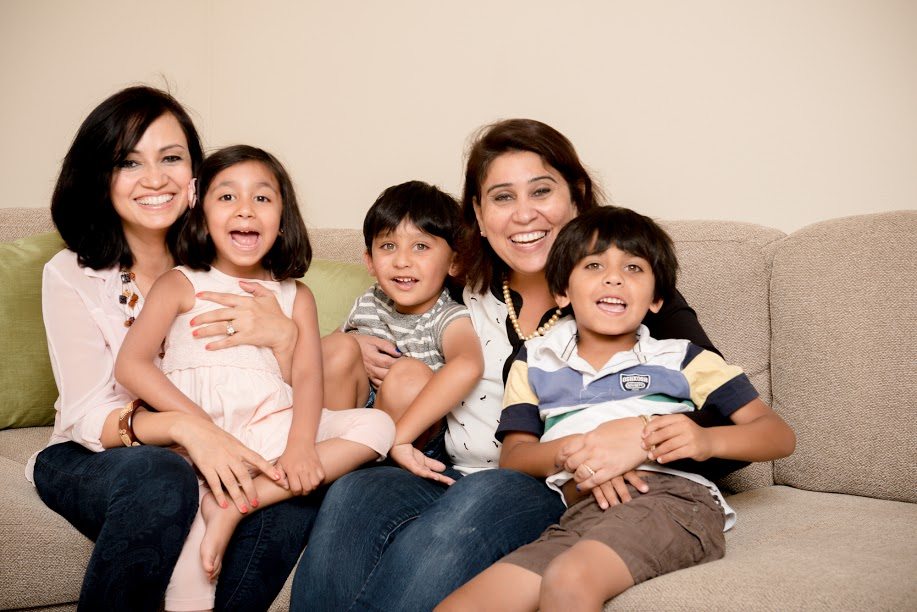
Ethnic Stories: Changing the Narrative
If you’re brown, come from Asia and practice a different religion, you’re often seen as exotic, sometimes as strange and almost always as a curiosity by the mainstream, and these misconceptions are often triggered by the stories that are written about ethnicity in the media. Shweta Chopra, who grew up in India but spent a large part of her life in Kuwait, Singapore and the US, had often felt the outsider in these different communities.
‘I remember when I first moved to Singapore, I was the only Indian girl in class,” she recalls. “I was amazed when my classmates found it amusing that I spoke good English and that I did not go to school riding an elephant back in India – how I wish it was actually true! Even when I moved to the US, many people assumed that I had an ‘arranged marriage’ and that I only ate naan and curry every day at home. I realized soon that the reason people make these assumptions is because that’s what the media portrays Indians to be like.”
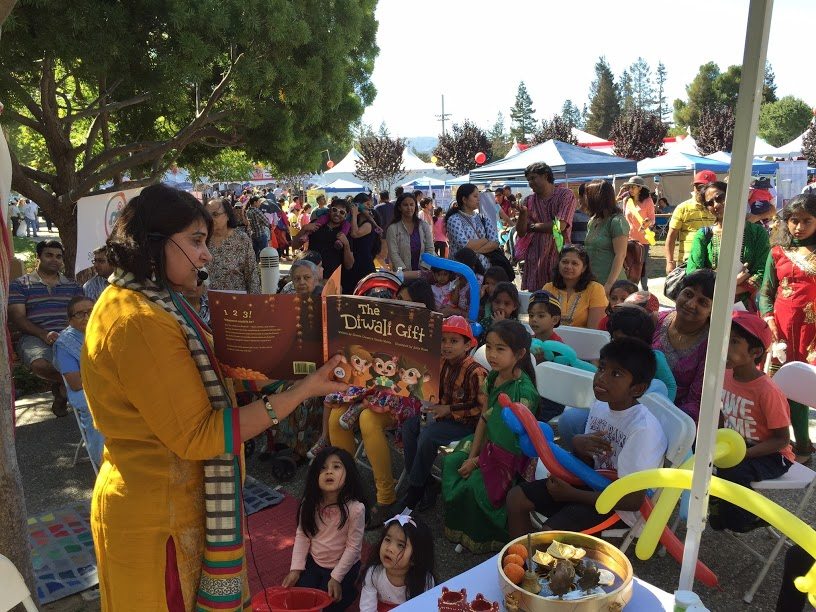
Creating Global Citizens
Over time, Shweta made friends of diverse ethnicities and assimilated with local cultures but deep down she always identified as an Indian. “I am quite confident and proud of it since that is part of my heritage and makes me who I am today. My parents always encouraged me to be welcoming and open to all cultures around us, while keeping our Indian values intact. I hope to pass on this good balance to my daughter growing up in the U.S.” So it is very important to share our culture with everyone especially with kids so that they do not grow up to be ignorant but rather informed global citizens
Her friend Shuchi Mehta, meantime, had grown up in India and had a very different experience. “Due to my Dad’s different job postings, we moved a lot as a family. This allowed me to experience the diversity of India first hand and that is something I cherish a lot and constantly try to pass on to my twin boys raised in the US. I hope they feel comfortable and curious about our Indian heritage and grow up to be proud of their Indian roots.”
On the Road to Entrepreneurship
Her experiences in US made her realize that many people around her were curious about India but their perceptions of its culture were very limited, and heavily influenced by the media.
With a background in molecular biology, Shweta had experience in research and development as well as in marketing and business development in the healthcare and biotech industry. Shuchi had an MBA from India, and experience in retail, ecommerce and the fashion industry. She had also been a team member at Citrus Lane, which was acquired by Care.com.
Making a decision to give up their jobs to help changing perceptions right in the school room, they turned entrepreneur with their own publishing and media company 3 Curious Monkeys, and their first offering is ‘A Diwali Gift’, a book for all children to understand this Indian festival.
“As a new mom I found almost no age appropriate resources for my daughter and her friends to experience India and its culture growing up in the U.S in a way that they could relate to while having fun,” says Shweta. “Kids are growing up on a healthy diet of Disney, PBS, Nick etc. however, there are more than 300 million Indian kids all around the world who do not see themselves reflected in the main media.”
.
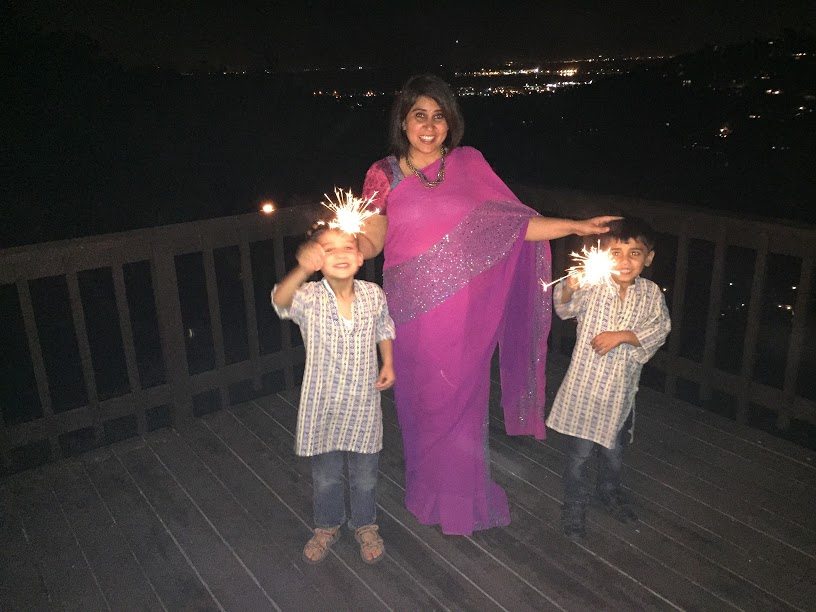
Shweta and Shuchi have reached out to schools and libraries across the US, UK and Canada. Says Shuchi: “In fact our partners at Reading Rainbow will be taking it to 500,000 classrooms nationwide and TES, the largest resource for teachers will be promoting our FREE Lesson Plan to over 7 millions teachers across the world.”
Their second product is a super interactive App, that encourages kids to learn about the vast diversity in India. It features accessories, weaves and languages from 8 distinct regions. This is available for free on all iOS devices
Q and A with Shweta Chopra and Shuchi Mehta of 3 Curious Monkeys
Shweta, how did your immigrant family manage to pass on their culture to you?
Since we moved a lot as a family, my parents made special efforts to keep us connected with our Indian culture especially during the holidays such as Diwali, Holi, Lodi, and Rakhi. They would invite both Indians and non-Indians to join in the festivities which gave us kids an opportunity to experience the sights, smells and sounds of our beautiful and diverse culture.
We had many family friends from the different regions of India so it was fascinating to hear so many Indian dialects. We would consider those our ‘code languages’ that only we could speak and understand. Not to forget, the scrumptious Indian meals my mom made every day which I consider a great asset and part of our Indian culture and try hard to pass on to my family.
Now that you are in the US and have a child of your own, how have you dealt with these new challenges?
Not only do I have to find ways to pass on my culture to my daughter, I have to ensure that my methods are fun, engaging and relatable to her current lifestyle and environment. I feel it’s important for me to instill a strong sense of identity in her and make her feel proud of her Indian roots and never force her to follow things just because I said so. I wish to instill a sense of excitement and curiosity in her so that she questions me about our own culture and I get an opportunity to answer them in the most rational and logical manner, all the while having fun.
Do you think most Indian-Americans, irrespective of their experiences, do face these identity crises?
I am not sure about identity crises but many a times I have heard and seen some Indian Americans shying away from their Indian roots. Like feeling shy speaking in their native Indian dialects, wearing traditional outfits or eating Indian food in front of non-Indian people. Sadly I have seen this identity confusion more so in young children who in an attempt to fit in with their peers, completely let go of the Indian parts of their lives.
I have seen many Indian Americans especially those who have immigrated to the US in the 70’s and 80’s live parallel lives where their home life and culture is different from when they are out. This could be because there was not much to merge their two lives, but things are changing fast. Our country is slowly becoming a minority majority state which is why it’s the best time to talk about cultures in the mainstream media.
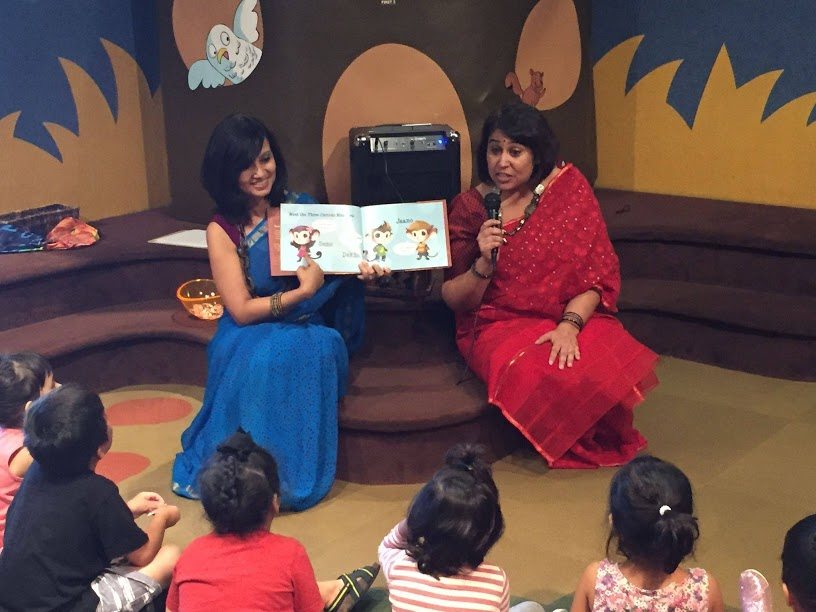
How did you get the idea of creating this company, 3 Curious Monkeys?
As good friends and first-time moms, Shuchi and I wanted to introduce our young kids to things Indian so we searched high and low for content and media which our kids would enjoy and could relate to. We applied our business skills and followed a step by step approach by conducting extensive research on current available Indian media with parents like us.
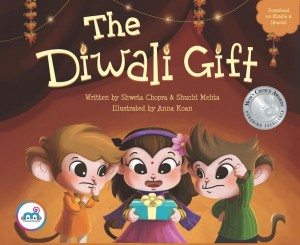
Our research showed that South Asian parents across the globe living in major cities such as San Francisco, New York, Houston, Chicago, Dubai, Toronto, London, Singapore, Hong Kong, Gurgaon and even Bangalore were disappointed with current Indian media options available for young kids. They perceived them to be unrelatable, violent, and not engaging enough to keep their kids interested.
On the other hand, parents that did not belong to the Indian Diaspora were very curious and eager to have their kids learn about the diverse Indian culture. To address these concerns, together we founded 3 Curious Monkeys with original characters that kids would enjoy and content that parents and teachers would be happy to share in an open education environment.
Diwali Fun for kids
Why did you think it was necessary to make the Diwali book – how did it differ from Diwali literature already in the marketplace?
Diwali was a natural choice for our first book because that’s one of the most popular holidays in India and is widely celebrated all across the world. ‘The Diwali Gift’ came about as a need for a fun and more relatable book for Diwali that lets all children regardless of ethnicity or race experience this major Indian holiday. The book shares the cultural icons that are associated with Diwali and focuses more on how it is celebrated rather than only why it is celebrated.
Our research indicated that while there were many stories with popular mythological characters, there were very few that focused on the rituals and hardly any with a fun adventure which kids enjoy. In fact, our story was inspired by a surprise gift that our kids received last year on Diwali and how it made them more curious about this festival and encouraged them to ask us more and more questions on our own family traditions
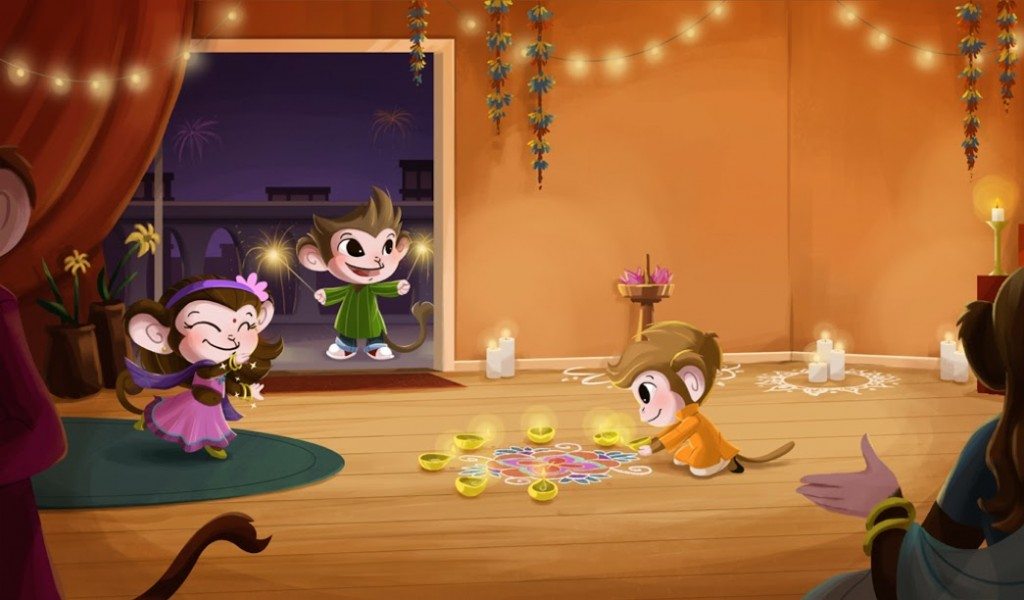
Why did you choose the monkeys as your characters?
We were inspired by Mahatma Gandhi’s “3 wise monkeys” that stand for ‘ see no evil, hear no evil and speak no evil’. We took a positive aspect of Gandhi’s 3 monkeys and through our medium we want to encourage all kids to see, hear and learn more about India. Thus, the names of our cute and relatable characters – Suno, Dekho, and Jaano.
How has the book been received?
The response from the community has been overwhelming. We never expected that our products could trigger such a great sense of excitement and curiosity in kids of all ethnicities and not just those of South Asian diaspora. Kids can instantly relate with Suno, Dekho, Jaano. They enjoy them so much that some have even inquired about where to find their costumes so they can dress up like them on Halloween!
The diverse community of parents and educators love our engaging book which has received The Mom’s Choice Award and has also become Amazon’s bestseller holiday book. It comes with a free lesson plan that educators can download from our website and use it to learn and talk about Diwali in an open education environment.
What’s the reading plan and connection with Stanford?
Diwali celebrations in schools especially outside of India are usually a parent driven initiative. If there is no parent willing to talk about it in the classroom, many times the holiday does not get mentioned. Our extensive research indicated that the main reason that Diwali was not on the mainstream calendars in US schools was because teachers did not have the resources needed to talk about it.
So to fix this problem, we worked with a top curriculum designer from Stanford University (part of the team who developed the Art in Action programs) to develop a Common Core guided lesson plan on Diwali. This lesson plan comes with 2 activities and can be adapted for 20, 40 or 60 mins of the classroom time. It is designed for Grades Pre-K, T-K, K and 1st Grade.
We are working with several school districts that are open to sharing the lesson plan and are already using it in their classrooms. We hope that more and more teachers and parents can use this free resource to take Diwali outside our homes and share it with their multicultural communities.
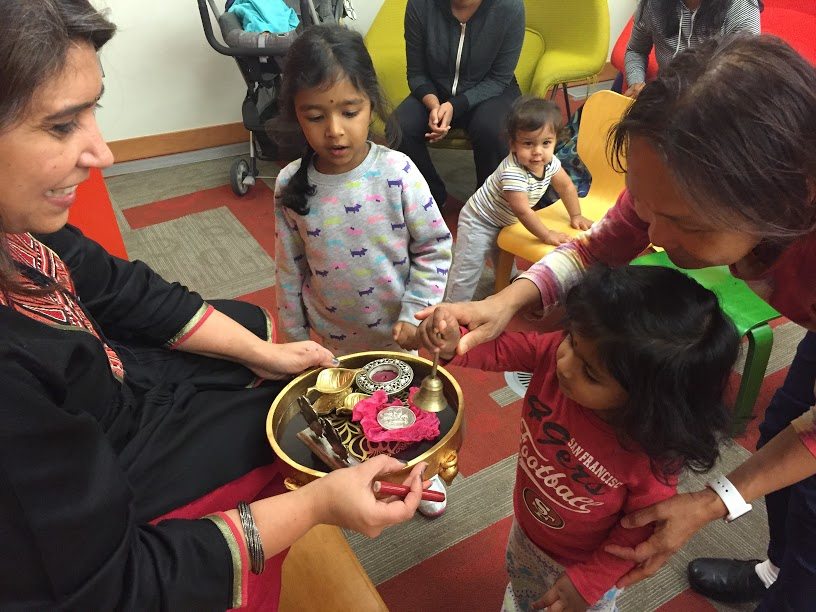
How have your own children reviewed the book?
Our own children simply love the book and can recite it word by word. They identify closely with Suno, Dekho, and Jaano and are happy to see themselves reflected in books. We are constantly given story ideas by our very own young authors and we can’t wait to implement these in our upcoming series.
Why do you think it’s so important to pass on culture and rituals to kids?
Culture to us is anything and everything that has some significance to individuals or groups. From carving pumpkins on Halloween, baking Christmas cookies, painting diyas during Diwali, and setting up dolls on Golu to dancing Garba and breaking fasts with the entire family during Ramadan. It is the sounds, smells and stories shared by families, generation after generation which keep us grounded and makes us who we are. So it’s good to let kids experience culture in a way they can relate to which would in turn make them curious enough to quest for themselves.
Do you regret leaving your field of work or is this truly satisfying for you?
We want 3 Curious Monkeys to do what ‘Dora the explorer’ did for Latino culture. We wish to bring our Indian culture out of our homes and share it with the world in the most engaging and fun manner. Through our age-appropriate cultural books, toys, and app, we wish to help build self-confidence and a strong sense of identity among children as they grow up in multicultural environments. Yes, we will continue to write more books and, in fact, are looking to collaborate with talented writers and authors to bring their stories to life through this platform.
While we may have left our field of work we absolutely enjoy being entrepreneurs. It’s a roller coaster ride and we would not have it any other way especially when it concerns our kids and those like them. We hope that through our efforts, young children all around the world get to experience India and grow up to be global citizens.
Readers, would love your thoughts – what do you think of this effort and why is it important? Do share your own experiences and be entered for a copy of ‘The Diwali Gift’ for your kids.
